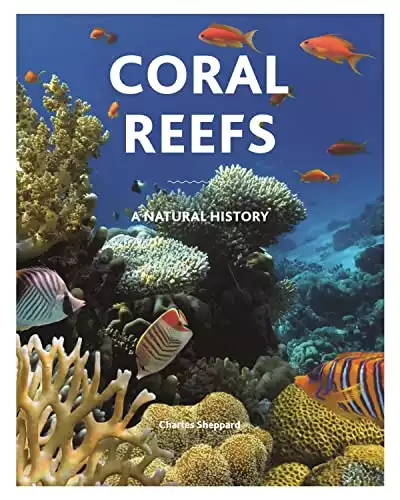Outforia Quicktake: Key Takeaways
- Coral is an essential part of ocean ecosystems, supporting a large percentage of marine life and protecting coastal areas.
- Coral bleaching occurs when corals become stressed and expel the microorganisms that provide them with nutrients, increasing their risk of death.
- There are over 6,000 species of coral, classified into two main subclasses: Hexacorallia (stony corals) and Octocorallia (soft corals).
- Coral reefs are some of the most biodiverse places on Earth, and their loss could have severe consequences for coastal communities and industries such as tourism and fishing.
- Coral is also a source of natural compounds used in medical treatments, making it an important resource for human health.
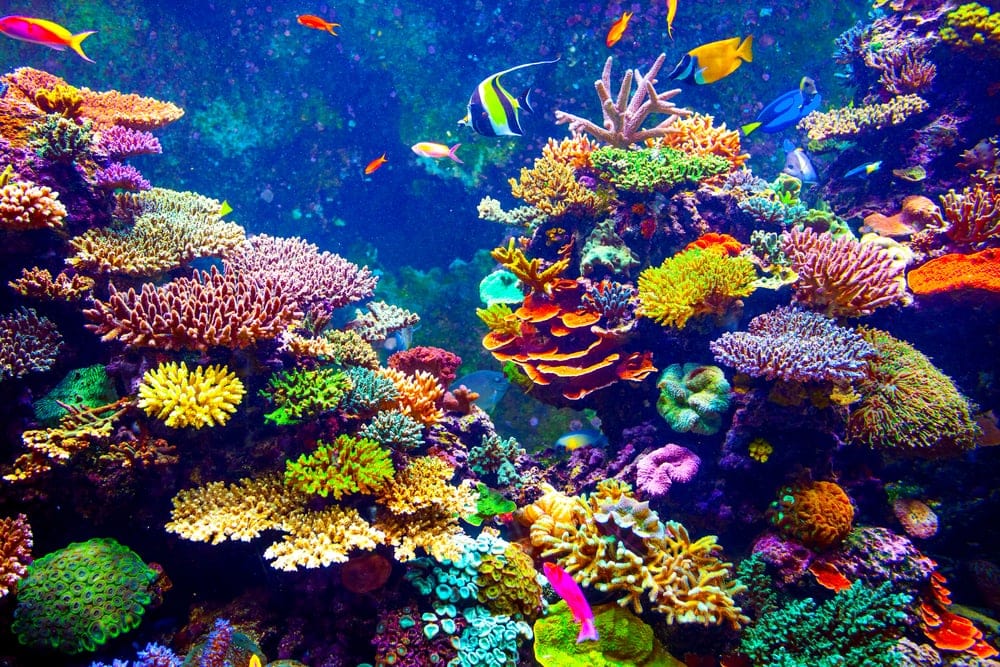
Whether you’re a keen scuba diver or simply an ocean lover, chances are pretty high that you’ve marveled at the wonders of the world’s colorful coral reefs at some point in your life.
But, how much do you really know about coral?
It turns out that, in addition to looking really cool, coral is also one of the most fascinating creatures on the planet. In fact, there are thousands of species of coral in the world, each of which plays its own role in supporting the greater ocean ecosystem.
If you’ve ever wanted to learn more about coral, then this article is for you. Up next, we’ll introduce you to the 22 most incredible types of coral. That way, you can impress your friends with your knowledge and be a better steward of our world’s oceans.
The 22 Out-of-this-World Types Of Coral
There are well over 6,000 different types of coral on this planet, so we couldn’t possibly talk about them all here. But, to help you learn more about these fascinating animals, we’ve created this list of the top 22 coolest types of coral on Earth. Here’s what you need to know:
1. Elkhorn Coral (Acropora palmata)
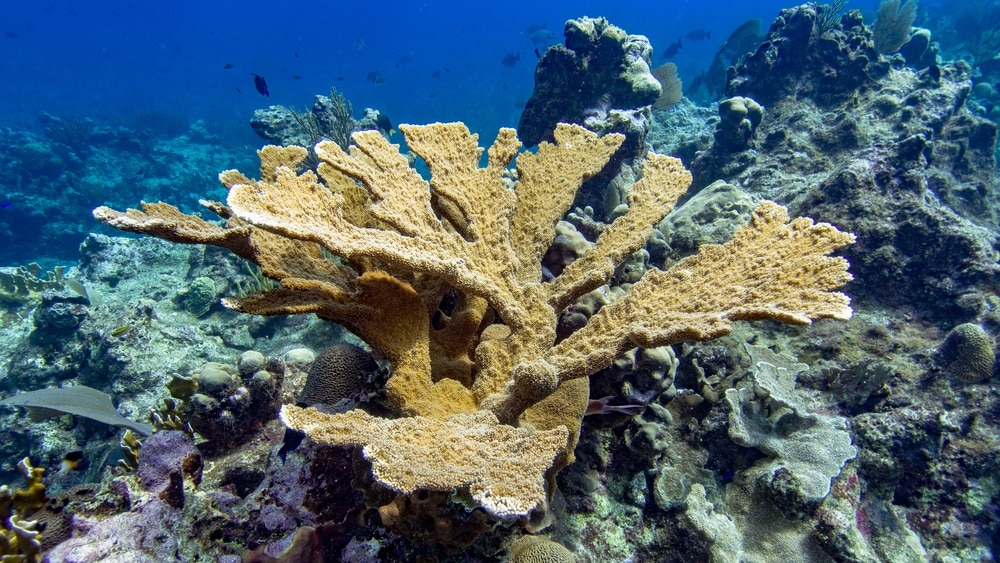
First up on our list is the elkhorn coral, which is one of the most widely distributed corals in the Caribbean Sea. It can grow to be up to 12 feet (3.7 m) long and 6 feet (1.8 m) high, so it’s truly a wonder to behold if you get to dive near any elkhorn coral reefs.
The elkhorn coral likes to grow in large groups called thickets, which are normally found in shallow waters. Due to its large size, it often provides an essential habitat for other types of marine animals such as the Caribbean Reef Octopus.
However, the species is currently threatened throughout its range due to a number of factors, including the white band disease.
The white band disease kills the elkhorn coral’s tissues. In conjunction with climate change, pollution, and unsustainable fishing pressure, the white band disease has killed about 97% of the world’s elkhorn coral population. Thankfully, there are a number of organizations that work to protect elkhorn coral reefs from further damage.
2. Open Brain Coral (Trachyphyllia geoffroyi)
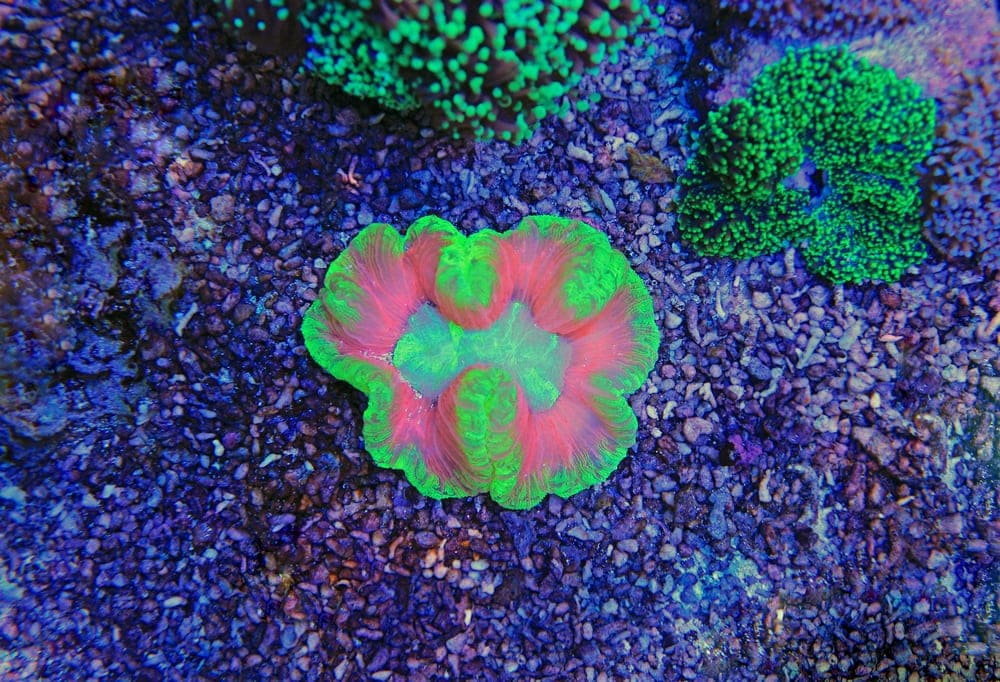
A highly popular coral species for use in home fish tanks, the open brain coral is a type of coral that has an odd-looking figure-eight shape and plenty of superb colors. In fact, as they get older, open brain corals can develop into a slew of different fluorescent colors, which is why they’re so popular among home reef aquarists.
These corals are naturally found in a wide range of different locations in the Indo-Pacific oceans, though they tend to prefer sandy and muddy seafloors. In particular, they are mostly found from New Caledonia to the Red Sea and they prefer water that’s less than 130 ft (40 m) deep.
Open brain corals are also prone to bleaching in the wild, which is one of the reasons why they’re listed as near threatened on a global level. However, over-harvesting for the aquarium trade is easily the coral’s biggest threat in the long term.
3. Bubble Coral (Plerogyra sinuosa)
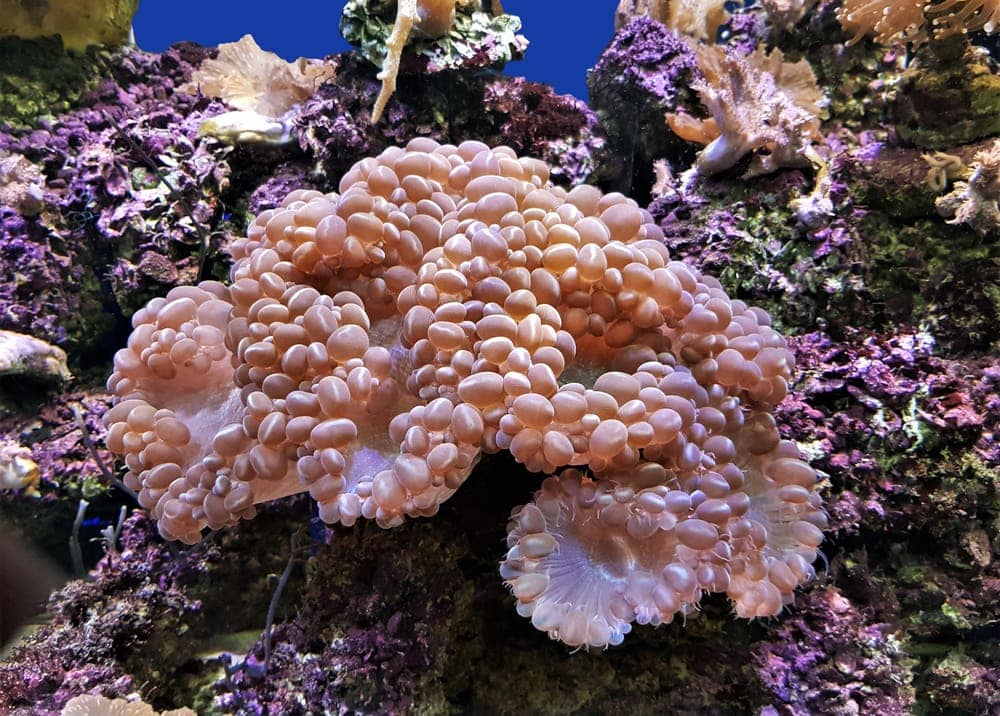
Boasting a spectacular bubble-like pattern, the bubble coral is an instantly recognizable coral that’s popular among reef aquarists. It has bubble-shaped tentacles that can actually expand and contract depending on the coral’s feeding schedule.
They are naturally found throughout the Indo-Pacific oceans from about the Red Sea to the Line Islands.
Interestingly, these corals live in a symbiotic relationship with some dinoflagellates (single-cell eukaryotes). These tiny dinoflagellates are able to photosynthesize, which provides the bubble coral with most of its necessary nutrition.
Nevertheless, like most corals, even the widely distributed bubble coral is listed as near threatened. Its biggest threat is climate change.
- Discover the amazing diversity of coral life forms and the critical importance of coral reefs to the health of our oceans.
- Explore the representative examples of coral species from around the world with more than 200 exquisite color photos.
- Learn about the key aspects of coral's natural history and the causes of their rapid disappearance.
- Perfect for marine biologists, divers, and anyone fascinated by these remarkable sea creatures.
- Written by renowned marine biologist, Charles Sheppard, with contribution from Russell Kelley, a coral identification expert.
4. Staghorn Coral (Acropora cervicornis)
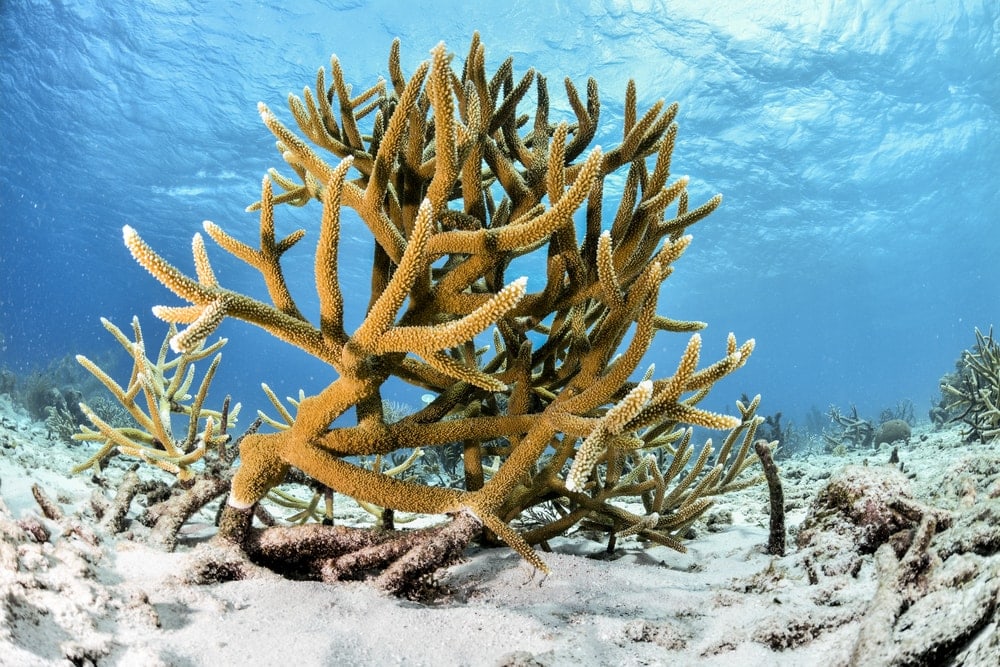
Similar to the elkhorn coral, staghorn coral is another important species in the Caribbean. The staghorn coral has more of a tubular shape than the elkhorn coral, making it appear more like the horns of an adult male deer.
Staghorn corals also grow in large thickets, which can be important habitats for fish. They tend to have branches that are a few inches thick but a single colony can be up to about 4 feet (1.2 m) high. They are normally found in shallow water in the Caribbean, as well as around the Bahamas and Florida.
Unfortunately, like elkhorn coral, staghorn coral has also been decimated by white band disease over the last few decades. Staghorn coral is less responsive to human interventions like dedicated breeding programs, however, so its populations are still on the decline.
5. Leaf Coral (Pavona decussata)
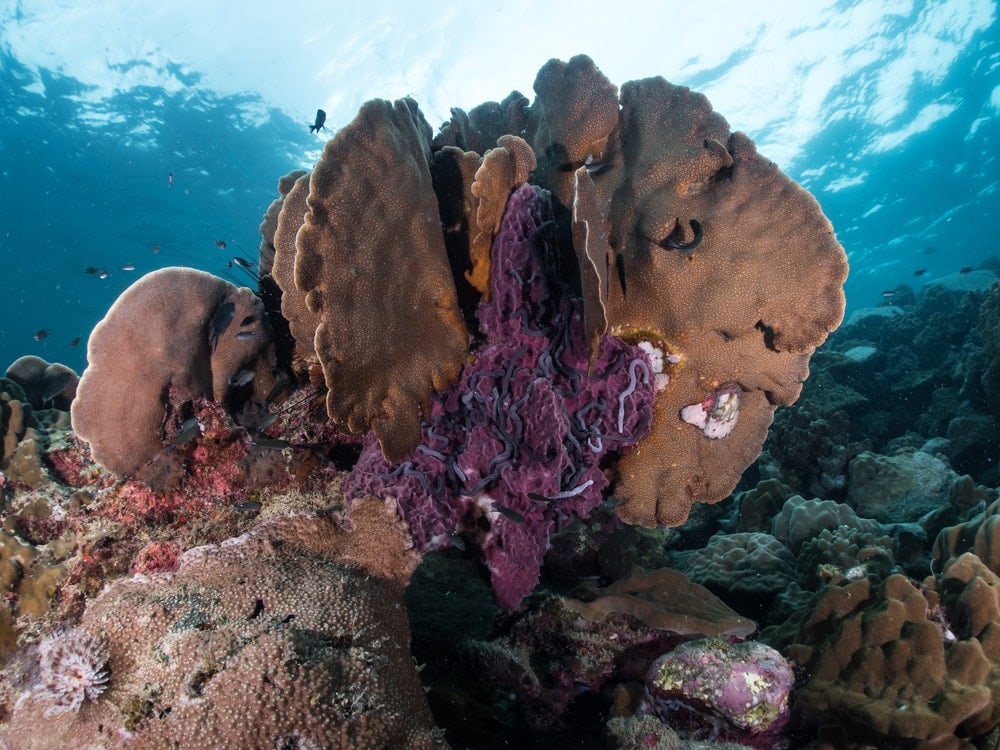
A rugged-looking type of colonial stony coral, the leaf coral is an animal that’s found in the shallow waters of the Indo-Pacific. Aptly named, it usually forms a leaf-like shape that’s only about 3 to 10 millimeters thick.
Leaf corals are widely distributed throughout the Indo-Pacific, however, relatively little is known about its overall population. Most leaf corals live no further than about 50 ft (15 m) in depth and they prefer to live on sloping surfaces.
It’s believed that the leaf coral is at risk of widespread bleaching, however, and it is listed as vulnerable by the IUCN.
6. Vase Coral (Montipora capricornis)
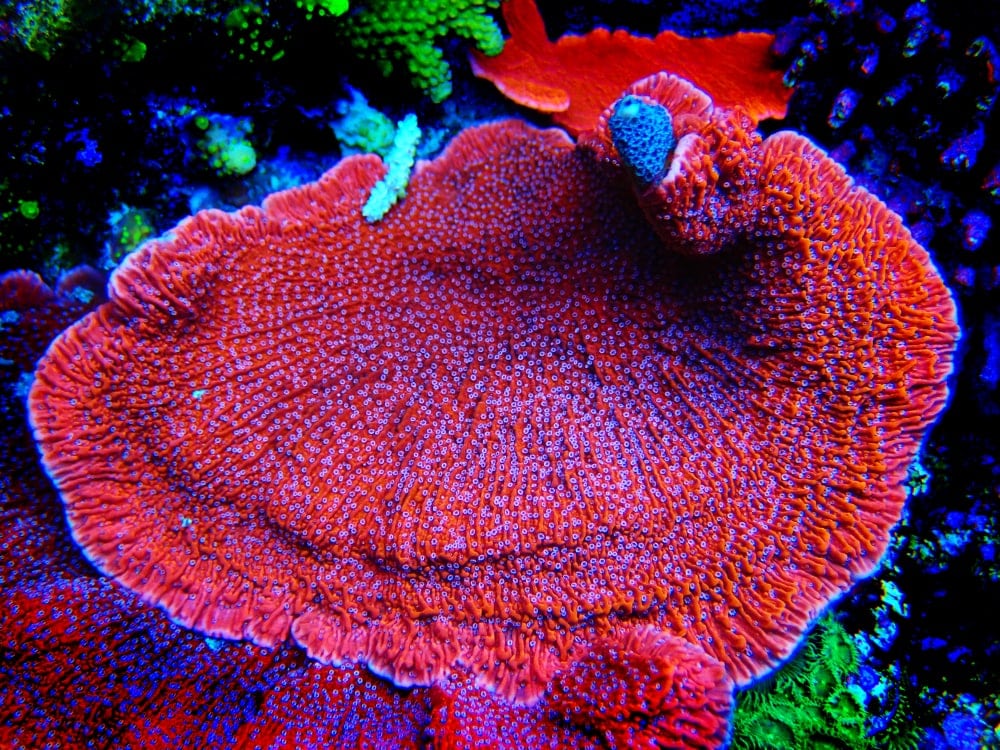
Also called Monti, after its Latin name, vase coral is a highly popular type of coral among home aquarists.
It is naturally found throughout the Indo-Pacific, especially in the Red Sea. For the most part, it prefers to live in the upper portion of the reef where the water is warmer.
Vase coral is a common sight in aquariums because it tends to tolerate captivity quite well. In fact, while it has multiple polyps, like all other corals, vase coral has a symbiotic relationship with zooxanthellae, which are single-celled dinoflagellates that perform photosynthesis.
So, when given enough sunlight, most vase coral can survive off the zooxanthellae’s photosynthesis alone.
7. Venus Sea Fan Coral (Gorgonia flabellum)
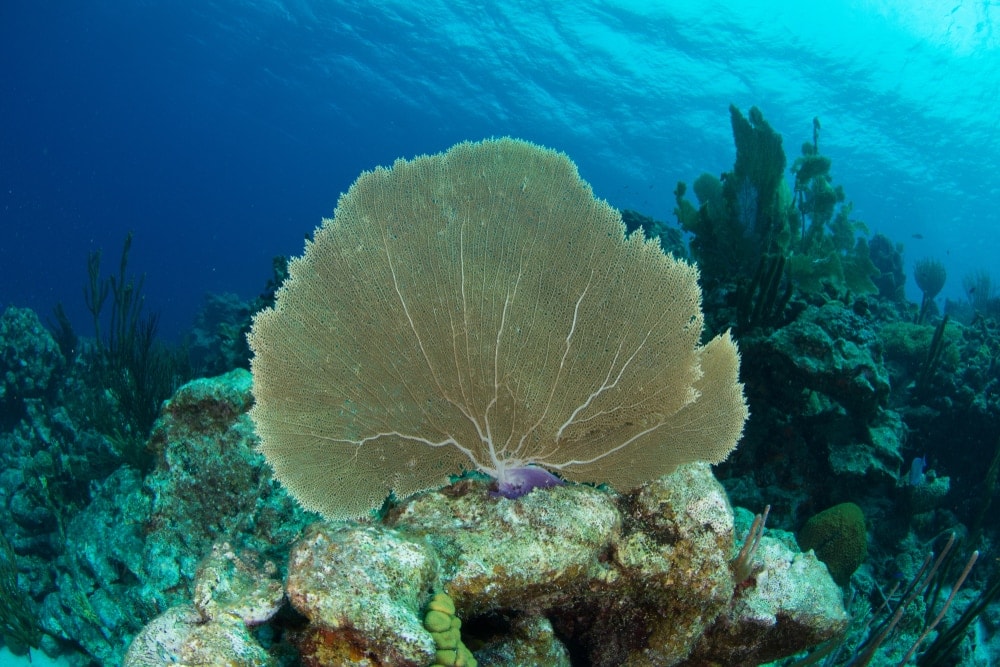
One of the best-known types of soft coral, the Venus sea fan tends to form massive fan-like structures that grow vertically upward from the ocean floor.
As a soft coral, it does not produce a hard shell of calcium carbonate. However, the Venus sea fan coral can hold itself upright in the current, growing to a height of about 6.6 ft (2 m) with relative ease.
The Venus sea fan coral is found throughout the Caribbean, though it is also very common in the Bahamas. They have a number of coral polyps on their tentacles that can filter feed for plankton that float through the current. However, the Venus sea fan’s symbiotic relationship with dinoflagellates provides it with much of its photosynthesized nutrition.
8. Sun Corals (Tubastraea)
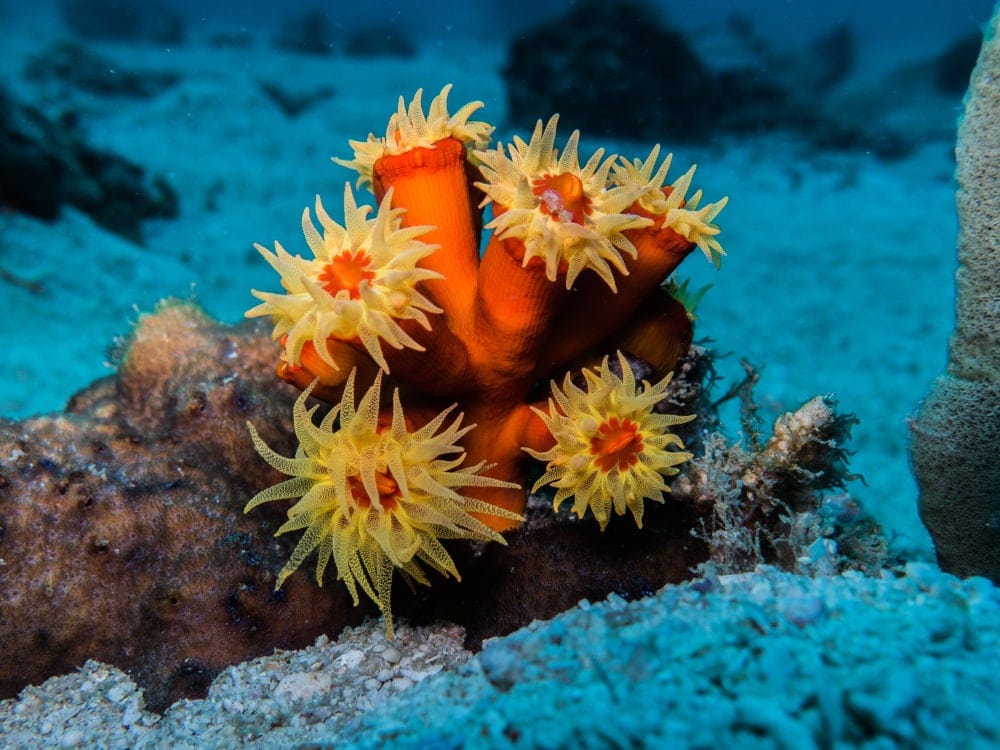
Sun corals are not one, but a whole genus of different cup corals that are found throughout the Caribbean. They are known to inhabit waters as far north as the Florida Keys, but they prefer deep waters, particularly around shipwrecks.
Since sun corals don’t rely on photosynthetic microorganisms for their sustenance, they’re actually one of the easier corals to care for in captivity.
They can eat surprisingly large food, such as mysis shrimp. However, since their polyps only open at night, they have to be fed during the nighttime hours. Who knew?
9. Lettuce Coral (Agaricia agaricites)
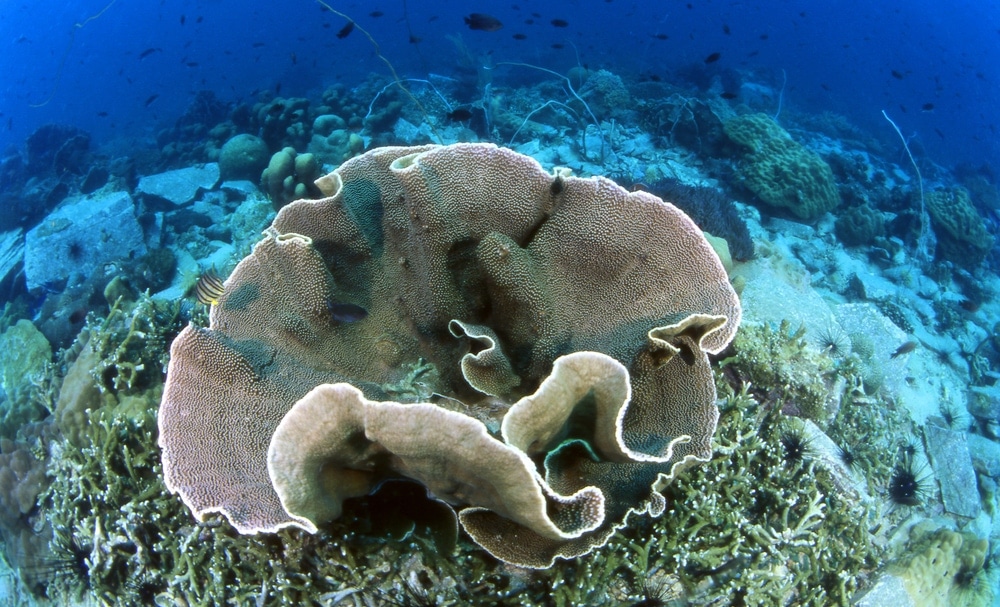
One of the more common corals of the Atlantic Ocean and the Caribbean, lettuce coral is, as you might’ve guessed, a type of coral with a distinctive lettuce-like appearance.
Lettuce coral can be found throughout the Gulf of Mexico and the Caribbean as well as near a number of atolls off the coast of Brazil. It prefers seagrass meadows, lagoons, and other fairly deep depths of down to 245 ft (75 m).
As it is the dominant species of coral in much of its range, the lettuce coral is one of the few coral species in the world that’s listed as a species of least concern. However, it is susceptible to bleaching, especially when El Niño events cause rising ocean temperatures in the region.
10. Organ Pipe Coral (Tubipora musica)
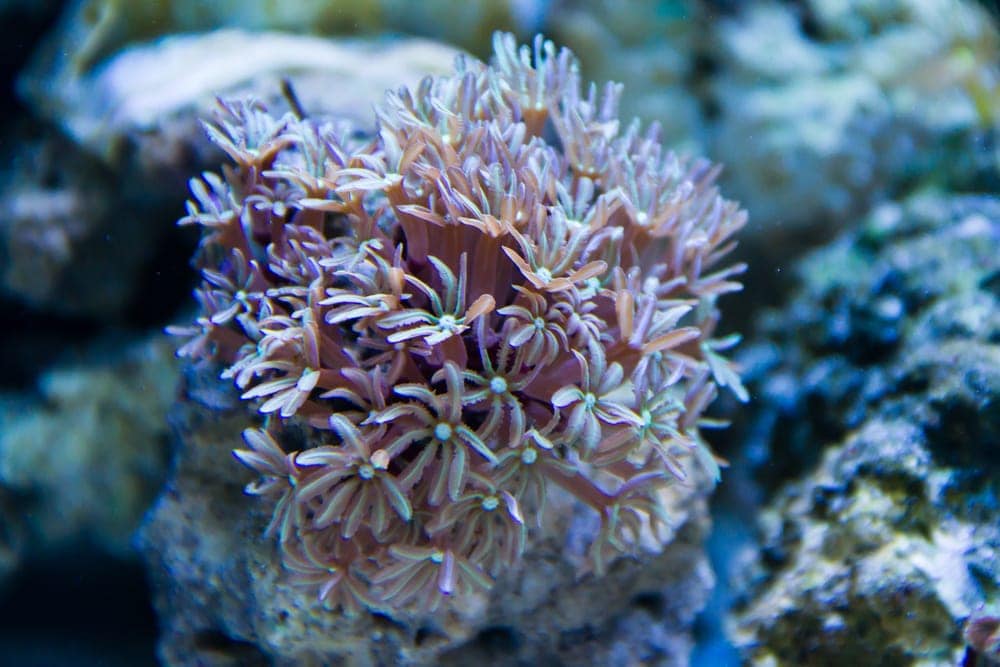
Organ pipe coral is a type of soft coral that’s found throughout the central and western Pacific.
Interestingly, despite being classified as a soft coral, organ pipe coral does have a hard skeleton of calcium carbonate. It is known for its long polyps, which tend to look a lot like organ pipes.
When organ pipe coral dies, it often leaves behind a skeleton of calcium carbonate. This skeleton can be bright red, which makes it particularly attractive to scuba divers who come across it.
That being said, the organ pipe coral can be quite difficult to care for, so it’s not a great species to keep in an aquarium. But, if you come across it while diving, it’s sure to be an awesome experience.
11. Grooved Brain Coral (Diploria labrynthiformis)
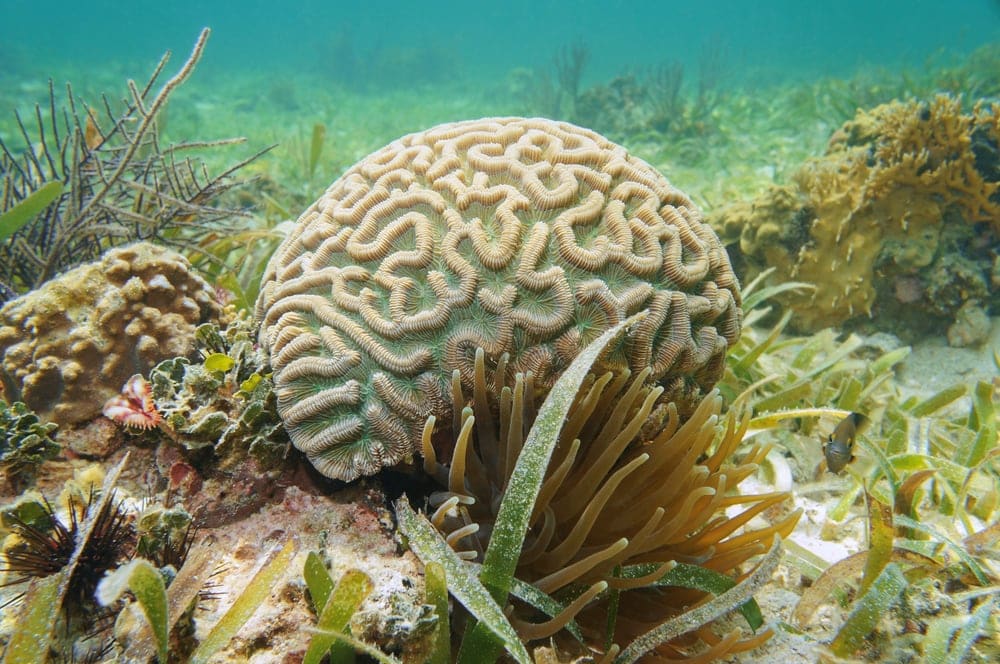
Aptly named, the grooved brain coral looks strikingly like a human brain. It boasts a set of deep grooves that look a whole lot like the folds of the human brain and it often has a grey coloration which only adds to its brain-like appearance.
Groove brain corals can grow to be about 6 feet (1.8 m) in diameter. They usually take on a circular shape but, while it might look like there is just one giant groove brain coral, these animals like to grow in groups of multiple individuals. So, what you see as a single specimen is often a small colony.
Thankfully, while the grooved brain coral is susceptible to bleaching and disease, it seems to be fairly resilient. Furthermore, it is still somewhat common throughout its range and the IUCN lists the grooved brain coral as a species of least concern.
12. Boulder Star Coral (Monstastrea annularis/Orbicella annularis)

Most commonly known as the boulder star coral, this species of coral is found in the western Atlantic, particularly around the Caribbean. It is one of the more abundant reef-building corals within its range and it can be found throughout the region down to a depth of about 260 ft (80 m).
The boulder star coral tends to form small boulder-shape structures with dozens of individual polyps. They are often found in colonies that look like piles of green or yellowish rocks, which can help with identification while diving.
That being said, the boulder star coral is currently listed as endangered due to the effects of climate change.
13. Great Star Coral (Montastraea cavernosa)
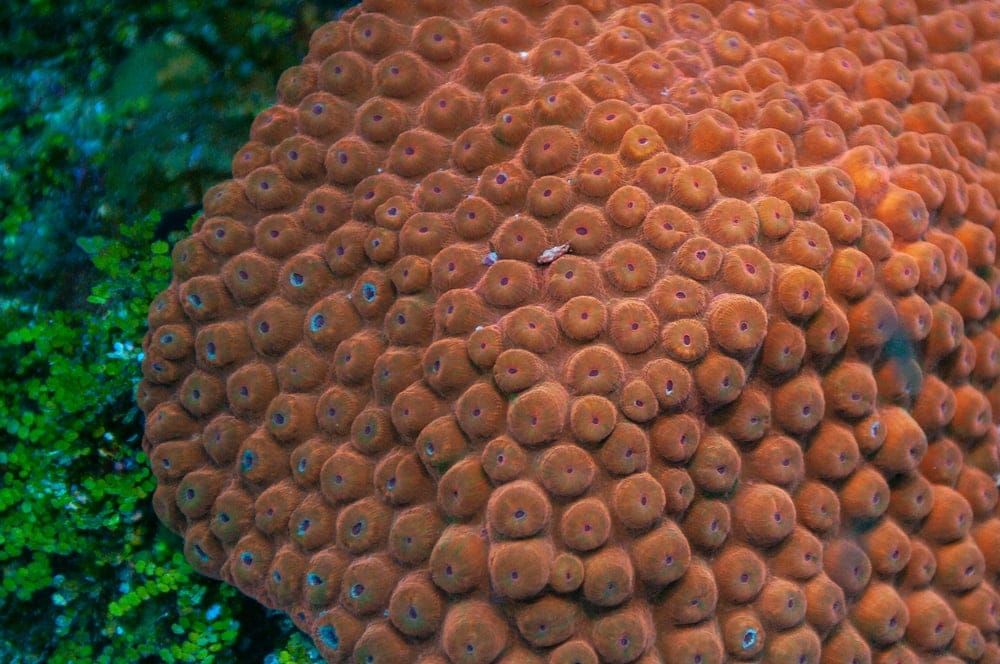
Similar to the boulder star coral, the great star coral is another animal that tends to form large, rock-shaped colonies. It is a type of stony coral that has a symbiotic relationship with zooxanthellae that provide it with the majority of its nutrition.
Most great star corals will form massive domes that look green, red, or brown in color. However, there are actually two morphs of this species, diurnal and nocturnal. So, the diurnal morphs, which tend to be brown, have polyps that expand and feed during the day and night. The nocturnal morph is usually brightly colored and it expands only at night to feed.
These corals are found mostly around Trinidad and Tobago, though you can find them around the Caribbean and the Gulf of Mexico. It is also occasionally spotted along the coast of western Africa.
14. Clubbed Finger Coral (Porites porites)
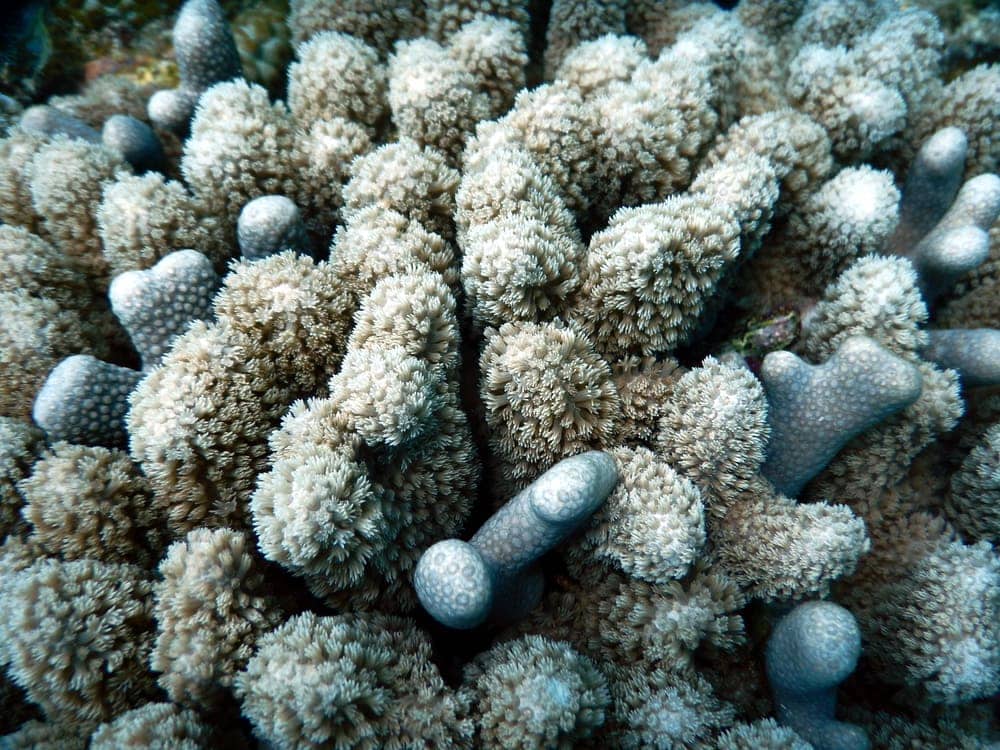
One of the smaller species of coral in our list, the clubbed finger coral is found in the Caribbean and in some parts of western Africa.
As you can guess from its name, the clubbed finger coral has small lobes that look a lot like thick fingers. These lobes usually aren’t more than about 1 inch (2.5 cm) wide and they tend to be white or blueish-grey in color.
Some clubbed finger corals can live impressively long lives. Although more research is being done to learn more about this species, it’s possible that an individual can live for many centuries.
Furthermore, the clubbed finger coral is one of the few corals that’s not currently at risk of extinction. It has a fairly widespread distribution, though some populations, particularly around the US Virgin Islands have been damaged by bleaching and disease in recent years.
15. Smooth Cauliflower Coral (Stylophora pistillata)
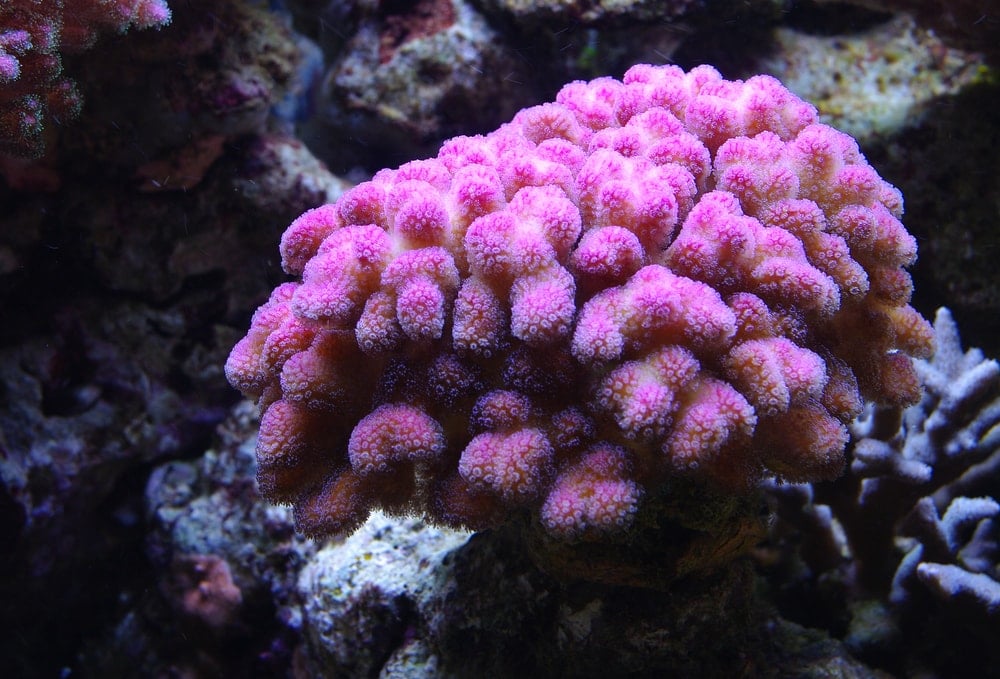
Thought that corals spend their lives in one place? Think again!
The smooth cauliflower coral actually likes to travel around quite a bit, thanks to its tendency to attach itself to floating objects, like shipwreck debris. Then, as these objects drift around in the ocean, the smooth cauliflower coral goes along for the ride. Who would’ve known?
However, the smooth cauliflower coral isn’t only known for its globetrotting tendencies. It also grows into a cauliflower-like shape with colorful, rounded branches. They’re usually found in the Indo-Pacific and you can find them at a wide range of depths in the ocean.
16. Massive Starlet Coral (Siderastrea siderea)
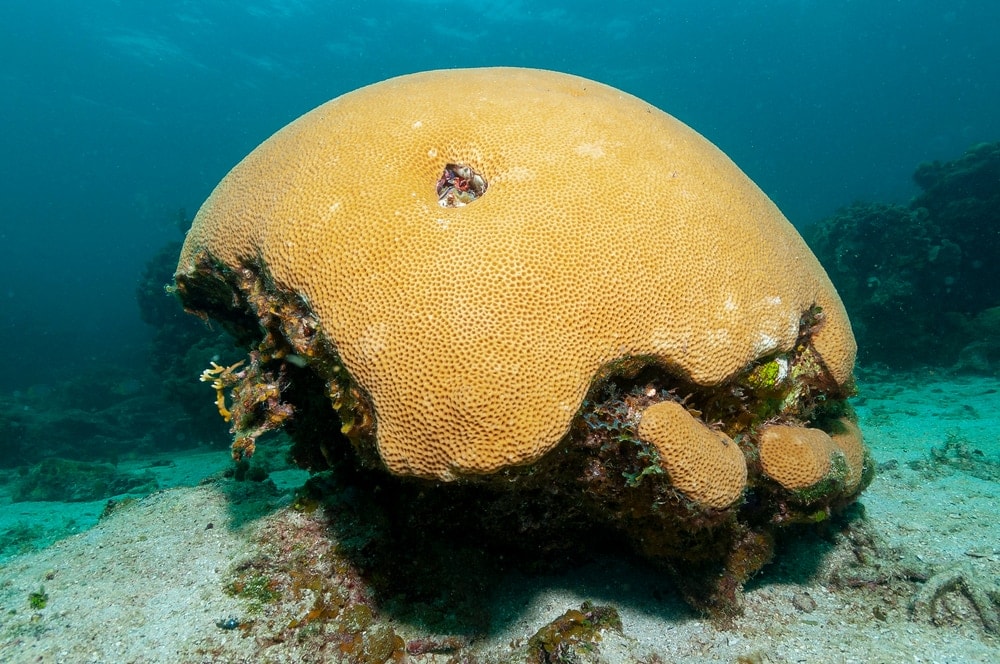
Massive starlet corals tend to grow into large dome-shaped structures that are composed of dozens of smaller individual corals. These corals often have a dimpled surface that makes them look a bit like an oversized golf ball.
They are usually found in the western hemisphere, particularly near Bermuda, the Bahamas, and other parts of the Caribbean.
These corals can be found at depths of up to about 230 ft (70 m). In fact, they really don’t like living in high-silt environments, like tide pools, so they’ll either grow in well-lit shallow waters or in the depths of the ocean.
17. Honeycomb Coral (Diploastrea heliopora)
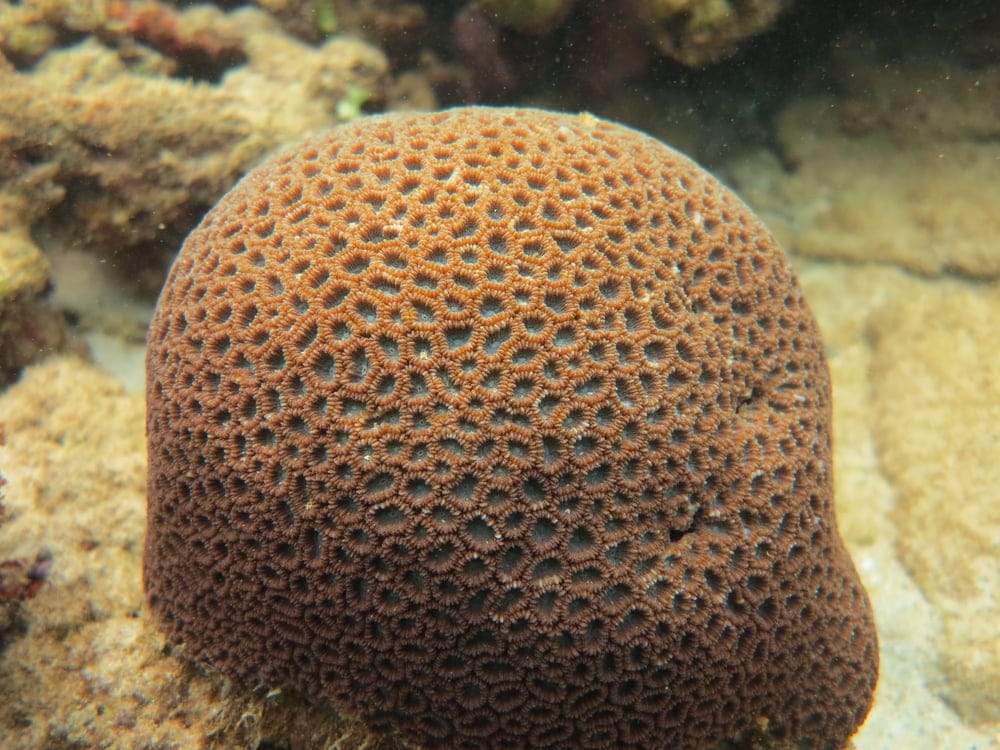
Forming beautiful honeycomb-esque colonies, the honeycomb coral is a widespread type of coral that’s found throughout the Indo-Pacific. It is particularly common around the Red Sea where it can be found at depths of up to 100 ft (30 m).
These corals like to form large colonies which can be up to 16 ft (5 m) wide. Sometimes, they can form dome shapes, but they often turn into large sphere-like boulders.
Honeycomb corals are unfortunately listed as near threatened by the IUCN. Their major threats include pollution and climate change, though trampling by visitors to coral reefs is also a major issue for the honeycomb coral’s survival.
18. Finger Coral (Montipora digitata)
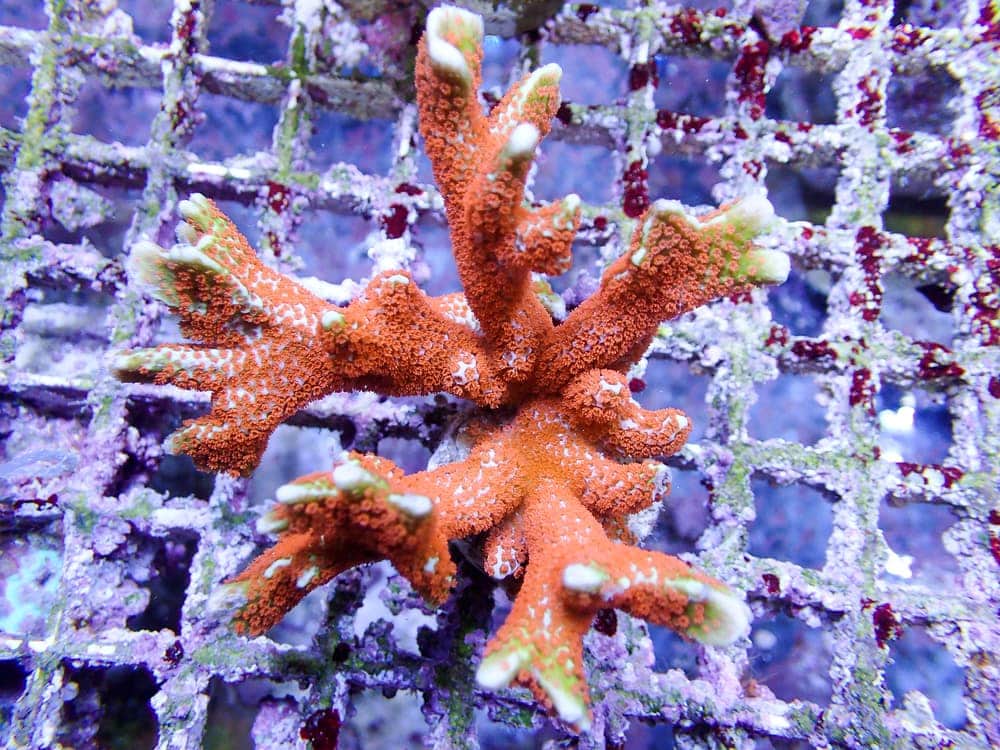
Although it shares a similar common name to the clubbed finger coral, the finger coral is a completely separate species. It is a type of stony coral that’s mostly found in eastern Africa, particularly around Mozambique.
This coral forms small bush-like structures with large, finger-esque branches. Nevertheless, unlike many of its neighboring corals, the finger coral seems relatively unaffected by bleaching. While climate change is an issue, the finger coral seems to resist bleaching damage and it is considered a species of least concern.
19. Common Mushroom Coral (Fungia fungites)
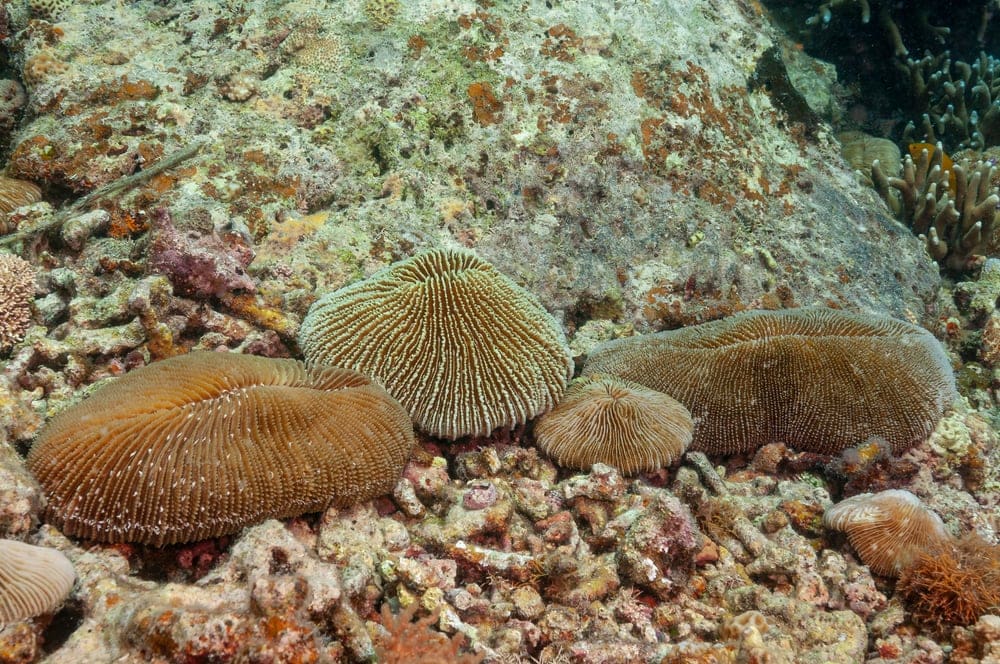
One of the more recognizable stony corals, the common mushroom coral is a relatively small animal found in the coral reefs of Hawai’i.
The common mushroom coral forms small oval shapes that look a whole lot like your standard wild mushroom. They prefer to live in mostly quiet reefs with relatively little activity. In fact, they don’t form colonies like many of the other corals in Hawai’i.
Furthermore, the common mushroom coral will only attach itself to a reef for the early part of its life. When it gets larger, it will break free from the reef and live on its own on the seafloor.
20. Precious Coral (Corallium)
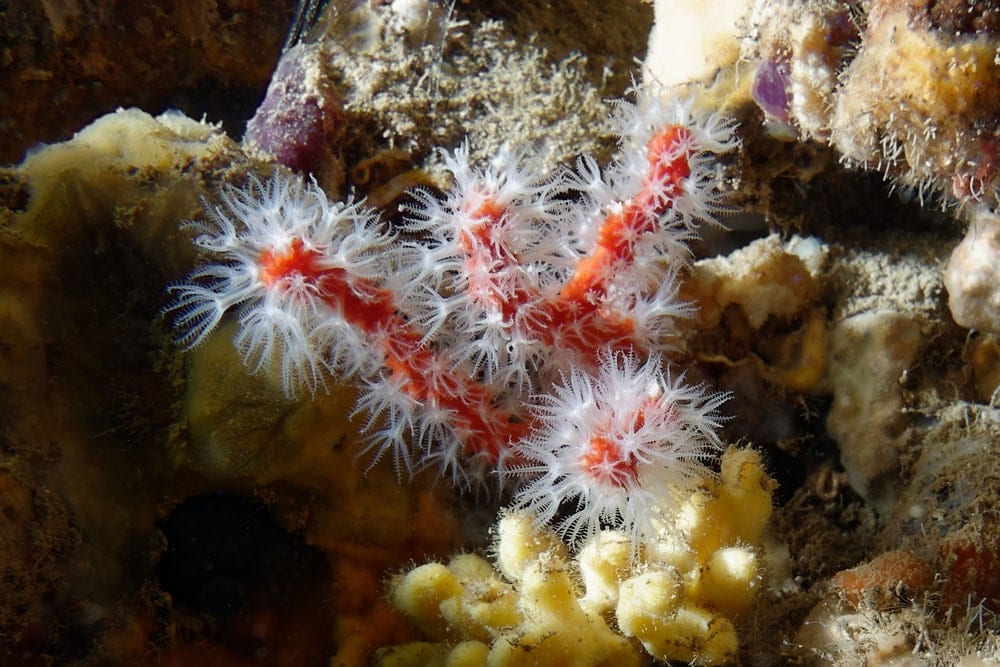
A popular source of coral material for jewelry and other manufactured goods, precious coral refers to the species within the genus Corallium.
There are about 31 species of precious coral on Earth, most of which like on rocky seafloors. They can actually be found in the Mediterranean, too, which isn’t common. In fact, you can find them around Sardinia and the Strait of Gibraltar, though they are also found near Japan and Taiwan.
What makes these corals special, however, is that they leave behind a hard skeleton of calcium carbonate when they die. These skeletons are often red in color, which makes them popular as a raw material among jewelry makers.
21. Carnation Coral (Dendronephthya)
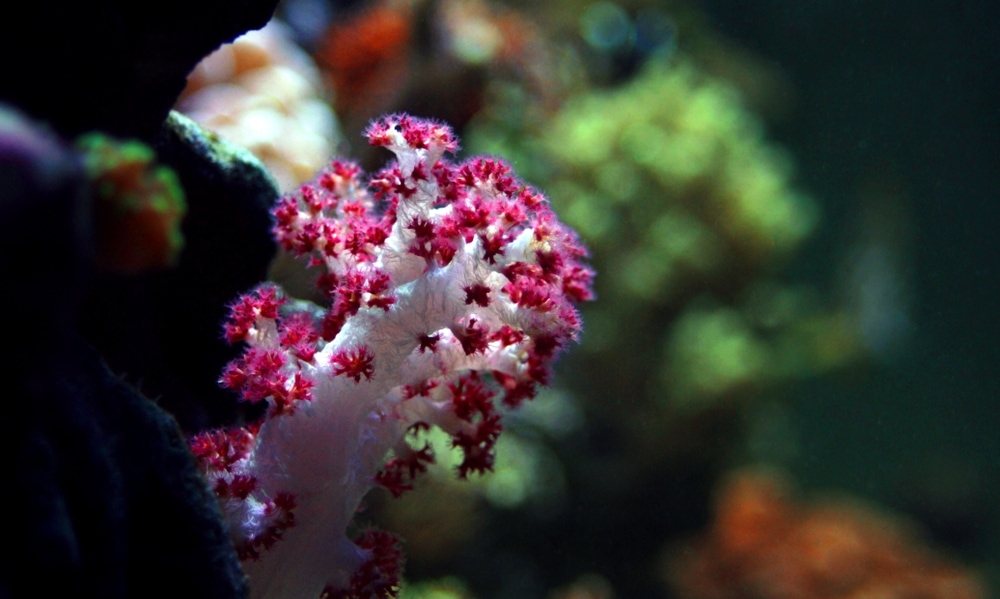
Often known as the carnation corals, all of the species within the genus Dendronephthya feature funky tree-like structures that make them a popular choice for home aquarists.
The carnation corals come in many different shapes and colors as there are dozens of species within the genus. They are mostly found in the tropical waters of the Indo-Pacific, especially in the Red Sea.
That being said, while carnation corals are popular among home aquarists, they are not easy to care for. Unlike most other corals, the carnation coral feeds only on phytoplankton so it needs a constant source of food in order to survive.
22. Colorful Sea Whip (Leptogorgia virgulata)

Last but not least, the colorful sea whip is a type of colonial soft coral that lives along the western coast of the Atlantic Ocean. In fact, it can be found as far north as the Chesapeake Bay and as far south as Brazil.
These corals have long, branch-like arms that can grow into massive structures, though the majority of colorful sea whips are no more than about 24 inches (60 cm) tall.
The colorful sea whip serves as a very important habitat for a number of other species, including the Atlantic wing oyster and a few different types of shrimp. Despite this, it is often damaged by shrimp trawling nets, which can wipe out large portions of the population.
You May Also Like: All 7 Harmless Sea Turtles in The World with Images, Infographic and Interesting Facts!
How Corals Are Classified
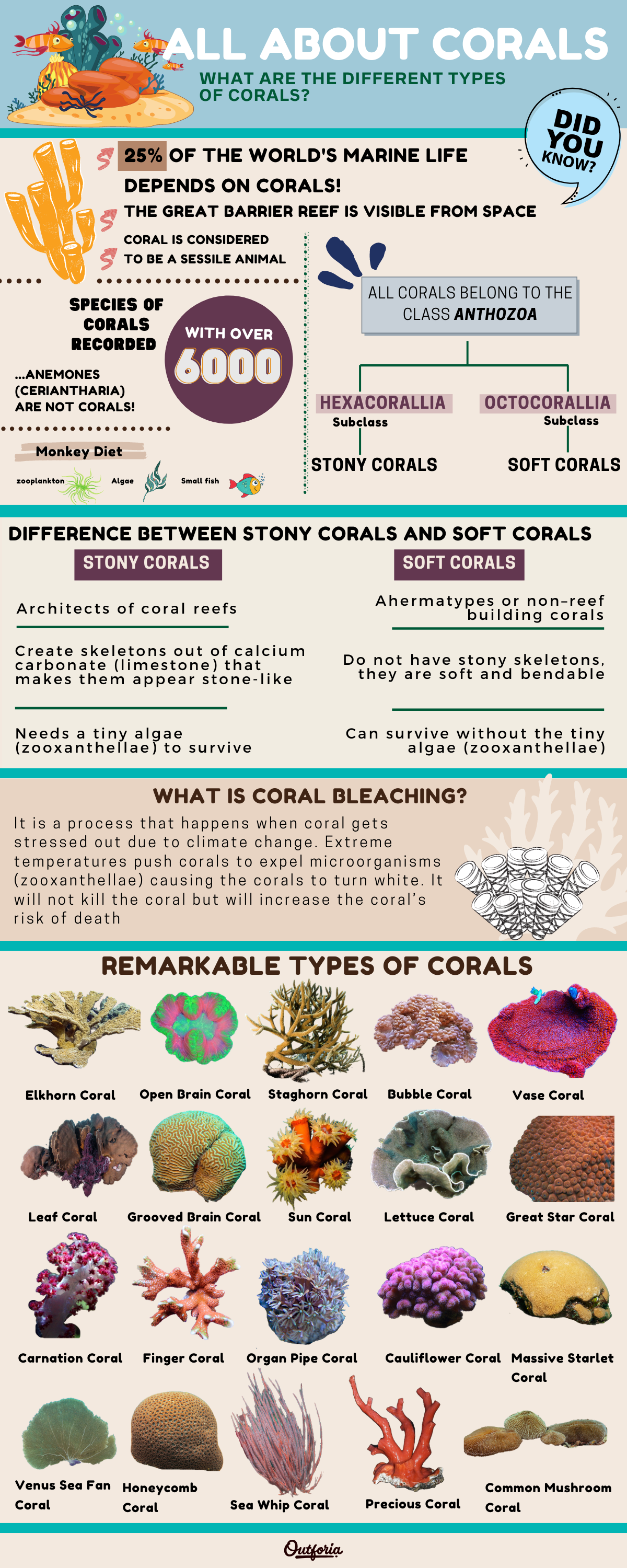
Share This Image On Your Site
<a href="https://outforia.com/types-of-coral/"><img style="width:100%;" src="https://outforia.com/wp-content/uploads/2021/04/Types-of-coral-infographic.png"></a><br>Corals Infographic by <a href="https://outforia.com">Outforia</a>With over 6,000 species of coral in the world, scientists have had a tricky time trying to categorize and classify all the different coral species.
All corals belong to the kingdom Animalia (yep, corals are animals!), the phylum Cnidaria, and the class Anthozoa. Beyond the class Anthozoa, however, things get a little hectic.
The class Anthozoa is technically subdivided into 3 subclasses. This includes:
- Subclass Hexacorallia – The subclass Hexacorallia includes the order Scleractinia, which is all of the stony corals.
- Subclass Octocorallia – The Subclass Octocorallia is home to the order Alcyonacea, which contains the soft corals.
- Subclass Ceriantharia – The subclass Ceriantharia is actually not a type of coral. This subclass includes the sea anemones, which, while related to coral, do not have a skeleton-type structure. Rather, anemones are filled with fluid while corals have an exoskeleton on each polyp.
Since sea anemones aren’t technically corals, we won’t focus on them here. But, in this section, we’ll give you a quick look at the world of coral taxonomy to help you better understand these fascinating creatures.
1. Subclass Hexacorallia (Stony Corals)
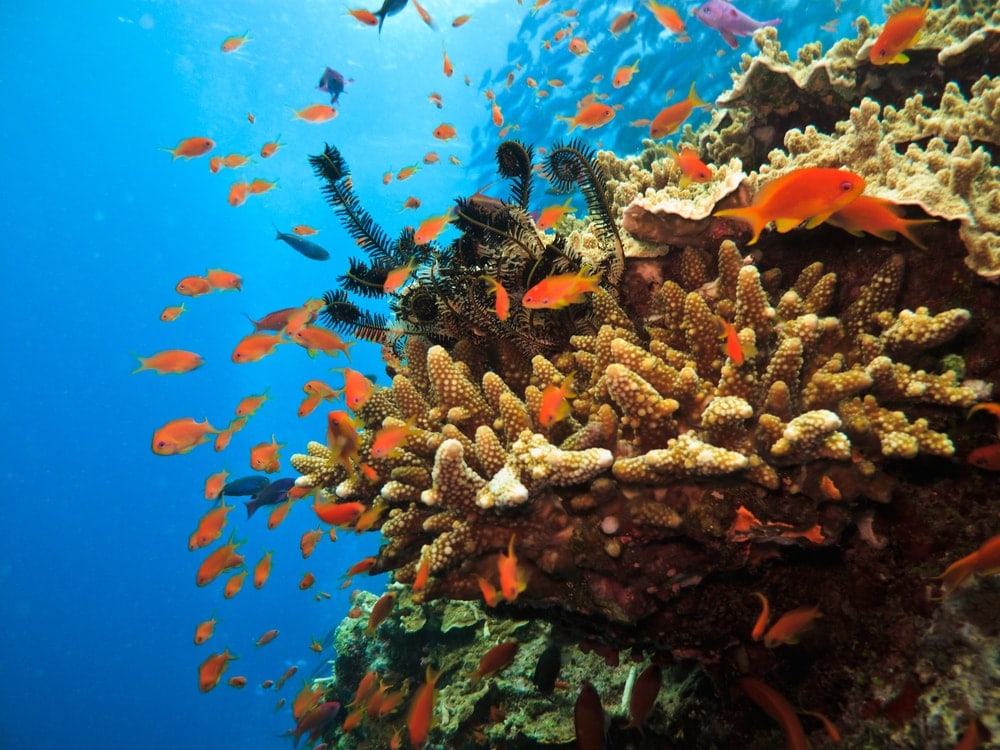
The first subclass of coral that we’ll discuss is the subclass Hexacorallia. This subclass is also known as the stony corals because many of them have a calcite exoskeleton that makes them appear hard and stone-like.
The real difference between the stony corals and the soft corals, however, is their shape.
Stony corals have body segments with fewer than 6 axes of symmetry. This might seem like a pretty arbitrary distinction, but that’s what the taxonomists decided, so we all simply have to follow suit. That being said, soft corals usually have simple, unbranched body structures with more than 8 tentacles. So, they’re often easy to distinguish from stony corals.
Within the subclass Hexacorallia, there are 35 families. However, there are thousands of species and not all have actually been classified in a species so there are many stony corals that scientists don’t know much about.
Stony corals are also very difficult to classify due to their great diversity. Some of the major families in this subclass include:
- Acroporidae
- Agariciidae
- Astrocoeniidae
- Caryophylliidae
- Dendrophylliidae
- Euphylliidae
- Faviidae
- Flabellidae
- Fungiidae
- Merulinidae
- Micrabaciidae
- Montastraeidae
- Oculinidae
- Pocilloporidae
- Poritidae
- Rhizangiidae
- Turbinoliidae
- Mussidae
2. Subclass Octocorallia (Soft Corals)
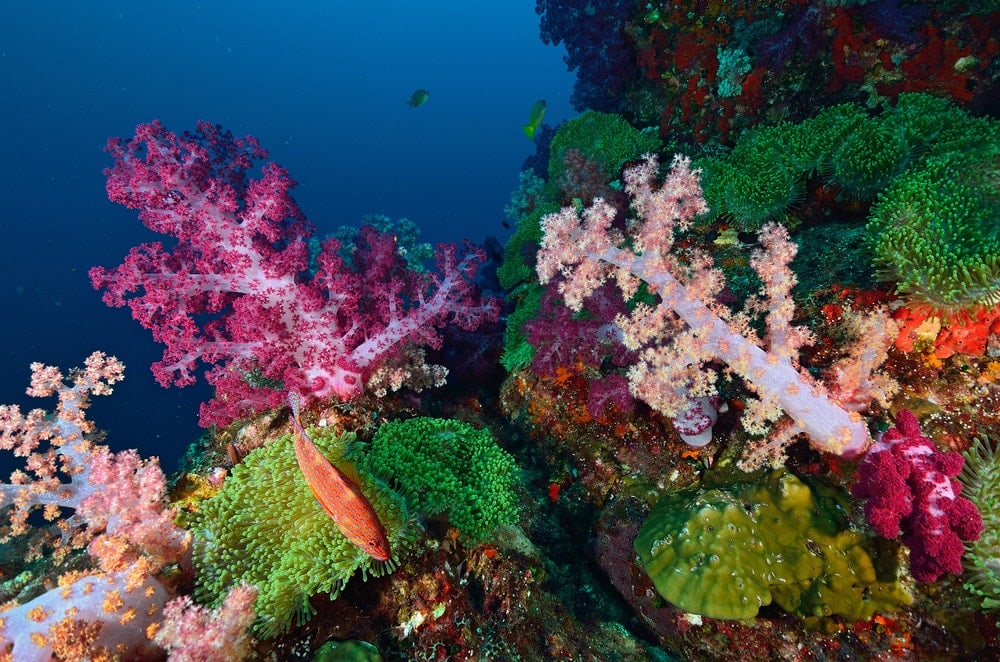
The subclass Octocorallia contains some 3,000 different species of soft corals. These corals usually have at least an 8-fold symmetry, so they include species that are commonly referred to as the gorgonians, the sea pens, and the blue coral.
As we’ve mentioned, the soft corals usually don’t have a very well-developed exoskeleton like the stony coral. Though, the real defining feature is that they tend to have longer, unbranched tentacles.
Like with all things coral-related, though, the taxonomy of the soft corals below the subclass level is complex. There are 6 orders and more than 40 families of soft corals, but, like the stony corals, some species have not yet been classified. Some of the major families include:
- Alcyoniidae
- Nephtheidae
- Xeniidae
- Chrysogorgiidae
- Ellisellidae
- Isididae
- Primnoidae
- Gorgoniidae
- Plexauridae
- Taiaroidae
- Anthothelidae
- Coralliidae
- Melithaeidae
- Paragorgiidae
- Parisididae
- Subergorgiidae
- Clavulariidae
- Tubiporidae
You May Also Like: All 25 Playful Species of Dolphins with Cute Images, Fun Facts and More!
What Is Coral Bleaching?
If you’re interested in corals, at some point, you’ve probably heard people talking about coral bleaching. But, what is coral bleaching, you might ask?
Essentially, coral bleaching is a process that happens when coral gets stressed out. Of course, coral doesn’t get stressed out by its math homework like we humans might, but it does become stressed out when there are major changes in its environment.
For example, when a coral’s habitat starts to get much warmer or much colder than it normally is, the coral starts to get a bit nervous. Eventually, if these extreme temperatures continue for too long, the coral will physically expel the microorganisms that live on its surface in a process known as bleaching.
This might not seem like a big deal, but these microorganisms provide most coral species with vital nutrients through photosynthesis. So, when the coral expels these microorganisms, it has less access to sustenance that it needs to survive.
The process of bleaching usually turns coral white due to its lack of food and the lack of algae living in their tissues. While bleaching on its own won’t kill coral, it does greatly increase the coral’s risk of death.
If the conditions that led to the bleaching (e.g., warm water, lots of pollution, or extreme low tides) continue, the coral is at a much higher risk of death. As a result, long-term bleaching events can completely wipe out sections of a coral reef.
You May Also Like: All You Need To Know About Biomes
Coral Fun Facts
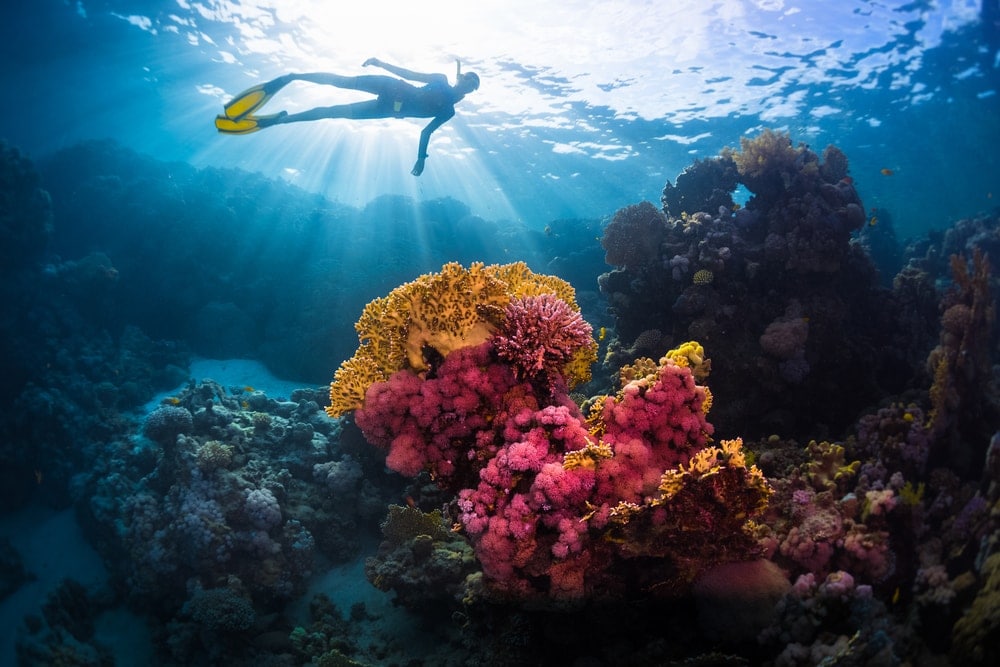
Fancy yourself as a veritable coral expert? Here are some coral fun facts that you ought to know:
1|Coral is the Medicine Cabinet of the Ocean
While most people think of medicine as something that’s artificially created in a lab somewhere, most medicine is actually derived from natural compounds.
In fact, many medicines are derived from various coral species.
How? Well, some coral species have unique compounds that aren’t found in any other life form. That’s because corals have had to develop their own chemical defense systems over the millennia to protect them from predators.
As a result, we humans can often use these chemicals to create medication for a wide range of diseases. So, if you ever do have to take medication when you’re feeling ill, you likely have coral to thank.
2|25% of the World’s Marine Life Depends on Coral
While most marine species don’t live in coral reefs, about one-fourth of all marine life does live in a coral reef for some part of its life cycle. Indeed, the secure, sheltered environment created by coral reefs makes it the perfect place for small organisms to grow before they’re ready to swim into the great blue beyond.
3|The Great Barrier Reef is Visible From Space
Yep, that’s right—astronauts can see the Great Barrier Reef from space!
Okay, they can’t see the individual corals in the reef, but there are some superb images of the outline of the Great Barrier Reef that have been taken by satellites. Some of the best photos of the reef were taken back in 2004 by the Envisat satellite, which used a spatial resolution of 980 ft (300 m) to create the images we see today. That’s pretty darn cool, if you ask us!
You may also like: Learn the 10 Different Types of Habitats that Animals and Plants Call Home: Complete with Images, Fun Facts, Descriptions, and More!
Coral FAQs
Here are our answers to some of your most commonly asked questions about coral:
What Exactly Is Coral?
Coral is considered to be a sessile animal, which means that they, like plants, tend to root themselves in one place. So, unlike other marine animals such as octopuses, corals don’t walk around on the seafloor or swim in the water. Instead, they permanently attach themselves to one place, normally the seafloor.
Why Is Coral So Important?
Coral is so important because it plays an essential role in the biodiversity of the world’s oceans. In particular, coral reefs are some of the most biodiverse places on the planet with some reefs, like the Great Barrier Reef, boasting thousands of fish and mollusk species.
Coral reefs can also actually protect coastal areas from surging seas and they can mitigate the effects of tsunamis. Plus, they are truly beautiful places that are important parts of the tourism industry in many coastal communities.
What Happens If We Lose Coral Reefs?
Coral reefs are an integral part of the world’s ocean ecosystem. If they were to completely disappear, we could see a number of severe consequences, such as the collapse of tourism in certain areas, damage to the global fishing industry, and surging seas in coastal areas.
Can Corals Feel Pain?
Since we humans can never know what it’s like to actually be a coral, we can’t say for sure that a coral can’t feel pain. However, corals have very simple nervous systems (called a nerve net) and no brain. So, it’s highly unlikely that they can feel pain, at least in the way that we humans conceptualize pain.
Where Can You Find Coral Reefs?
The majority of coral reefs are located in tropical waters. In particular, coral reefs are prominent in the Caribbean, Oceania, and Eastern Africa. However, you can find non-reef coral species in various parts of the world, including in parts of the Mediterranean.




